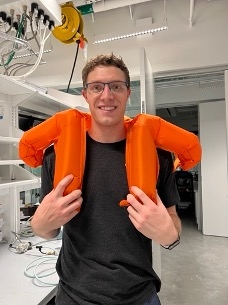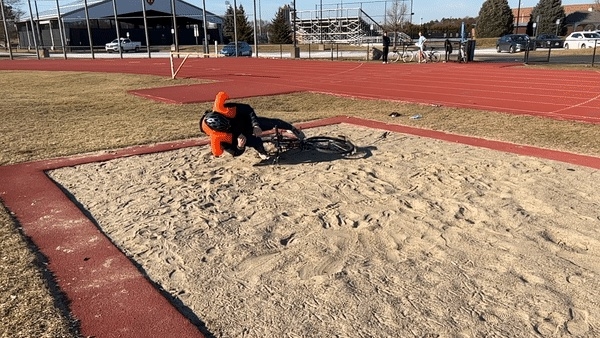Ethan Seder, S.B. '22, created an airbag for cyclists for his senior capstone project. (Credit: Ethan Seder)
Engineering Design Projects (ES 100), the capstone course at the Harvard John A. Paulson School of Engineering and Applied Sciences, challenges seniors to engineer a creative solution to a real-world problem.
CrashPak: Airbag for Cyclists
Ethan Seder, S.B. ‘22, mechanical engineering
What did you do for your project?
For my thesis, I built an airbag for commuter cyclists that deploys from a backpack in the event of an accident. The device contains three subsystems: electronics and an algorithm used for accident detection, a mechanical gas release mechanism to inflate the airbag, and an expandable textile airbag deployed to protect the upper torso of the user. During testing, the device was able to reduce impact force by 94%.
Where’d your project idea come from?
During my gap year from school in 2020-2021, I got into a bike accident and realized how shocking it is that the only safety solution available to cyclists is the helmet. The helmet has limited energy absorption and leaves the upper body of the cyclist unprotected. The goal of my thesis was to build an elegant solution that protects the upper torso of cyclists, while integrating into a backpack that is already carried by commuter cyclists.
What real-world challenge does this project address?
Every year there are roughly 1000 fatal bike accidents and 50,000 bike-related injuries in the U.S. alone. The lack of adequate safety equipment is to blame, and my project aims to solve this unmet need. My backpack, which retains its normal functions, is able to reduce the severity of injuries sustained by cyclists.
Ethan Seder's airbag uses electronics and a mechanical gas release system to deploy within 200 milliseconds of an accident. (Credit: Ethan Seder)
What part of the project proved the most challenging?
The most difficult part of this project was integrating the three subsystems together and ensuring the airbag could inflate in as little time as possible. If the device was too slow to deploy, the user would hit the ground before the airbag fully deployed, negating the protective benefits. I optimized the amount of gas released and the inflation mechanism to achieve a final inflation time of 200 milliseconds, which will sufficiently protect users.
What part of the project did you enjoy the most
I enjoyed the iterative building part of the project the most. My favorite days and nights occurred when parts would break and I had to brainstorm novel solutions that solved the issue I was facing. Those moments of rapid iterations and first principles approach is what made this thesis so enjoyable.
What skills did you gain through this project?
I learned how to manage a project with many complex parts. Throughout the thesis I had to make sure that I consistently pushed forward all subsystems of my thesis to ensure that the device would be completed by April 1. I achieved this by making sure that every week I pushed forward each subsystem as much as I could and made sure that any materials or advice I needed was planned for.
Press Contact
Matt Goisman | mgoisman@g.harvard.edu

